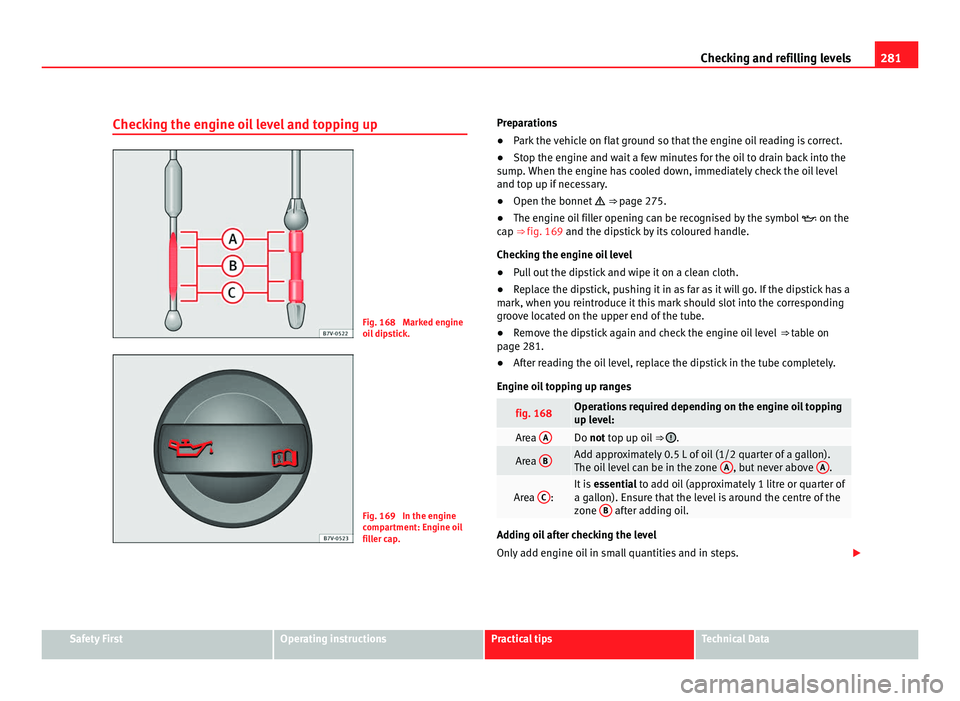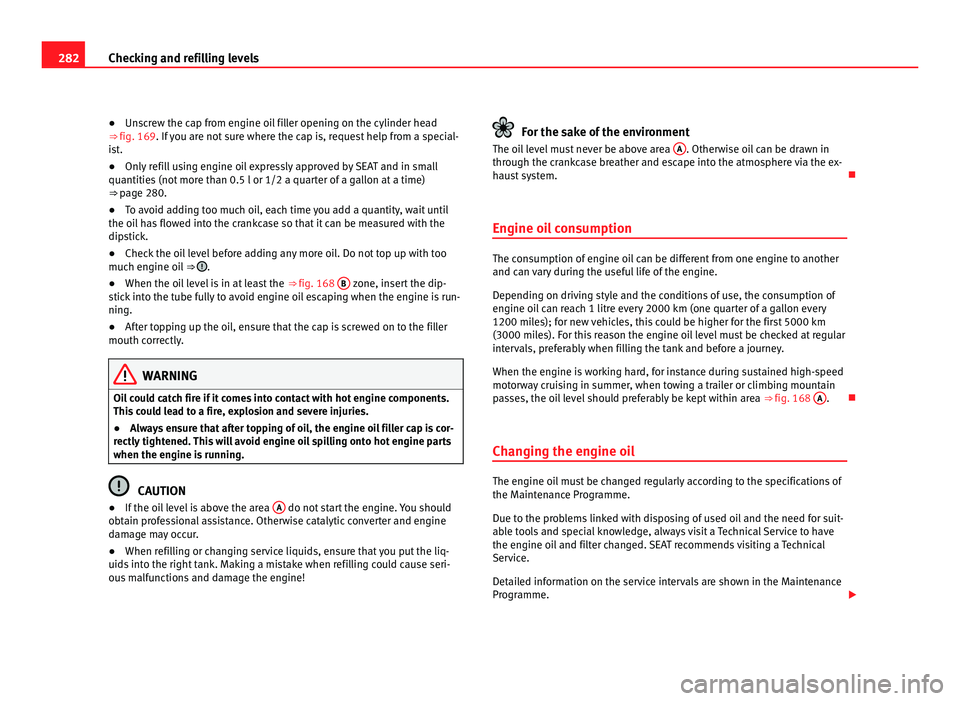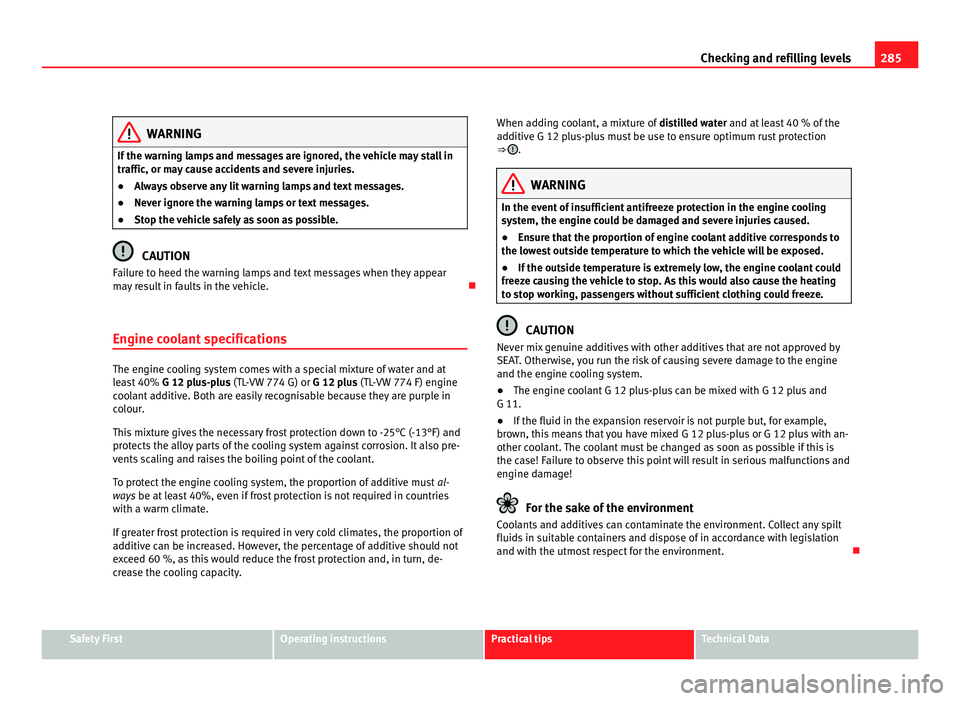adding oil Seat Alhambra 2011 Owner's Manual
[x] Cancel search | Manufacturer: SEAT, Model Year: 2011, Model line: Alhambra, Model: Seat Alhambra 2011Pages: 385, PDF Size: 7.92 MB
Page 283 of 385

281
Checking and refilling levels
Checking the engine oil level and topping up Fig. 168 Marked engine
oil
dip
stick. Fig. 169 In the engine
comp
ar
tment: Engine oil
filler cap. Preparations
●
Park the vehicle on flat ground so that the engine oil reading is correct.
● Stop the engine and wait a few minutes for the oil to drain back into the
sump.
When the engine has cooled down, immediately check the oil level
and top up if necessary.
● Open the bonnet ⇒ p
age 275.
● The engine oil filler opening can be recognised by the symbol on the
cap ⇒
fig. 169 and the dipstick by its coloured handle.
Checking the engine oil level
● Pull out the dipstick and wipe it on a clean cloth.
● Replace the dipstick, pushing it in as far as it will go. If the dipstick has a
mark, when y
ou reintroduce it this mark should slot into the corresponding
groove located on the upper end of the tube.
● Remove the dipstick again and check the engine oil level ⇒ tabl
e on
page 281.
● After reading the oil level, replace the dipstick in the tube completely.
Engine oil
topping up ranges fig. 168 Operations required depending on the engine oil topping
up lev
el: Area
A Do not top up oil
⇒ .
Area
B Add approximately 0.5 L of oil (1/2 quarter of a gallon).
The oil
l
evel can be in the zone A , but never above
A .
Area
C : It is
essential to add oil (approximately 1 litre or quarter of
a g al
lon). Ensure that the level is around the centre of the
zone B after adding oil.
Adding oil after checking the level
Only
a
dd engine oil in small quantities and in steps. Safety First Operating instructions Practical tips Technical Data
Page 284 of 385

282
Checking and refilling levels
● Unscrew the cap from engine oil filler opening on the cylinder head
⇒ fig. 169
. If you are not sure where the cap is, request help from a special-
ist.
● Only refill using engine oil expressly approved by SEAT and in small
quantities (not
more than 0.5 l or 1/2 a quarter of a gallon at a time)
⇒ page 280.
● To avoid adding too much oil, each time you add a quantity, wait until
the oil h
as flowed into the crankcase so that it can be measured with the
dipstick.
● Check the oil level before adding any more oil. Do not top up with too
much engine oi
l ⇒ .
● When the oil level is in at least the ⇒ fig. 168 B zone, insert the dip-
stic k
into the tube fully to avoid engine oil escaping when the engine is run-
ning.
● After topping up the oil, ensure that the cap is screwed on to the filler
mouth correctly
. WARNING
Oil could catch fire if it comes into contact with hot engine components.
This c
ould lead to a fire, explosion and severe injuries.
● Always ensure that after topping of oil, the engine oil filler cap is cor-
rectly tight
ened. This will avoid engine oil spilling onto hot engine parts
when the engine is running. CAUTION
● If the oil level is above the area A do not start the engine. You should
obt ain pr
ofessional assistance. Otherwise catalytic converter and engine
damage may occur.
● When refilling or changing service liquids, ensure that you put the liq-
uids int
o the right tank. Making a mistake when refilling could cause seri-
ous malfunctions and damage the engine! For the sake of the environment
The oil level must never be above area A . Otherwise oil can be drawn in
through the c r
ankcase breather and escape into the atmosphere via the ex-
haust system.
Engine oil consumption The consumption of engine oil can be different from one engine to another
and can
v
ary during the useful life of the engine.
Depending on driving style and the conditions of use, the consumption of
engine oil can reach 1 litre every 2000 km (one quarter of a gallon every
1200 miles); for new vehicles, this could be higher for the first 5000 km
(3000 miles). For this reason the engine oil level must be checked at regular
intervals, preferably when filling the tank and before a journey.
When the engine is working hard, for instance during sustained high-speed
motorway cruising in summer, when towing a trailer or climbing mountain
passes, the oil level should preferably be kept within area ⇒ fig. 168 A .
Changing the engine oil The engine oil must be changed regularly according to the specifications of
the Maint
en
ance Programme.
Due to the problems linked with disposing of used oil and the need for suit-
able tools and special knowledge, always visit a Technical Service to have
the engine oil and filter changed. SEAT recommends visiting a Technical
Service.
Detailed information on the service intervals are shown in the Maintenance
Programme.
Page 287 of 385

285
Checking and refilling levels WARNING
If the warning lamps and messages are ignored, the vehicle may stall in
traffic, or m a
y cause accidents and severe injuries.
● Always observe any lit warning lamps and text messages.
● Never ignore the warning lamps or text messages.
● Stop the vehicle safely as soon as possible. CAUTION
Failure to heed the warning lamps and text messages when they appear
ma y
result in faults in the vehicle.
Engine coolant specifications The engine cooling system comes with a special mixture of water and at
le
a
st 40% G 12 plus-plus (TL-VW 774 G) or G 12 plus (TL-VW 774 F) engine
coolant additive. Both are easily recognisable because they are purple in
colour.
This mixture gives the necessary frost protection down to -25°C (-13°F) and
protects the alloy parts of the cooling system against corrosion. It also pre-
vents scaling and raises the boiling point of the coolant.
To protect the engine cooling system, the proportion of additive must al-
ways be at least 40%, even if frost protection is not required in countries
with a warm climate.
If greater frost protection is required in very cold climates, the proportion of
additive can be increased. However, the percentage of additive should not
exceed 60 %, as this would reduce the frost protection and, in turn, de-
crease the cooling capacity. When adding coolant, a mixture of
disti
lled water and at least 40 % of the
additive G 12 plus-plus must be use to ensure optimum rust protection
⇒ .
WARNING
In the event of insufficient antifreeze protection in the engine cooling
sys t
em, the engine could be damaged and severe injuries caused.
● Ensure that the proportion of engine coolant additive corresponds to
the lowe
st outside temperature to which the vehicle will be exposed.
● If the outside temperature is extremely low, the engine coolant could
freeze c
ausing the vehicle to stop. As this would also cause the heating
to stop working, passengers without sufficient clothing could freeze. CAUTION
Never mix genuine additives with other additives that are not approved by
SEA T
. Otherwise, you run the risk of causing severe damage to the engine
and the engine cooling system.
● The engine coolant G 12 plus-plus can be mixed with G 12 plus and
G 11.
● If the fluid in the expansion reservoir is not purple but, for example,
brown, thi
s means that you have mixed G 12 plus-plus or G 12 plus with an-
other coolant. The coolant must be changed as soon as possible if this is
the case! Failure to observe this point will result in serious malfunctions and
engine damage! For the sake of the environment
Coolants and additives can contaminate the environment. Collect any spilt
fluids in s
uitable containers and dispose of in accordance with legislation
and with the utmost respect for the environment. Safety First Operating instructions Practical tips Technical Data